|
Örjan Martinsson
| |
|

(Royal Majesty's Life Guard on Foot)
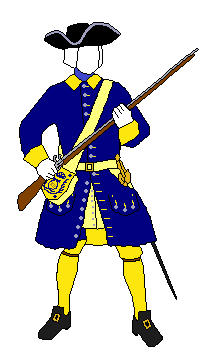
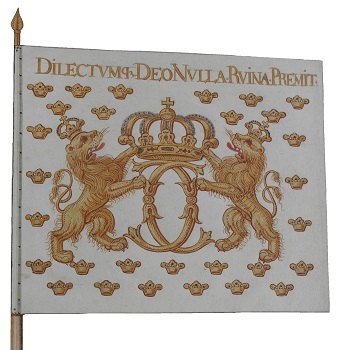
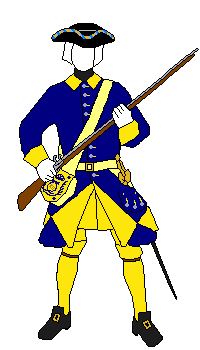
The Swedish infantry
was a formidable force during the Great Northern War and its most
distinguished regiment was Charles XIIs own guard regiment, the Livgarde.
This unit's elite status was acknowledged by their higher wages and hats
laced with gold, silver and silk. It was also, with first 1,800 men and
later 2,600 men, the by far largest regiment in the Swedish army.
In each battle the Livgarde took the lead and in the battle line they held
the place of honour furthest to the right.
The Livgarde
has won numerous victories in most of Sweden's war but there is no doubt
that its heydays were during the Great Northern War. Because in this war
they took part in the landing at Humlebæk in 1700, the battle of Narva in 1700,
the crossing of the Düna in 1701, the battle of Kliszow in 1702, the siege of Thorn
in 1703
and the battle of Holowczyn in 1708. However, after all these successes they suffered a crushing defeat at Poltava
in 1709
and only half of the Livgarde remained when the Swedish army surrendered at Perevolochna
three days later.
The Livgarde was restored after the disaster but the new guard would not
experience any triumphs as the old one had done. Recruitment problems kept
it as a garrison regiment in Stockholm until 1718 when it participated with almost full
strength in Charles XII's last campaign in Norway.
|
|
Organisational History of the Livgarde 1618-1792
The original
role of the Livgarde was to be the king's bodyguard and since kings in all
ages have had bodyguards it is possible to trace the lineage of the Livgarde
all the way to Gustav
Vasa's rebellion in 1521. However, in practise there were several different
guard regiments during Sweden's age of greatness (1611-1718), which for
various reasons disappeared and were replaced by new regiments. To be exact
there were four incarnations of the Livgarde during this period, created in
turn by Gustav II Adolf,
Kristina, Charles XI and Charles XII. The continuity that existed between
these regiments was the small force that was always left in
Stockholm to guard the palace while the rest of the regiment went on
campaign.
The Drabant
Corps that had protected the kings of the Vasa dynasty was in 1618
transformed into a company in a five year old mercenary regiment which Gustav II Adolf
elevated to be "Konungens
livregemente" (the King's Life Regiment). It would also be called
Hovregementet (= the Court Regiment) or Gula regementet (the Yellow
Regiment, after the colour of their uniforms). The original drabants
retained however a special status by consisting of Swedes and being called
the king's Livgarde (Life Guard). The rest of the regiment consisted of
Germans. After participating in Gustav II Adolf's campaigns in Livonia, Prussia
and Germany the regiment was split up after the battle of Lützen 1632. The Livgarde escorted
the king's dead body to Stockholm and stayed there as a palace guard. The
remaining part, which was now only called the Yellow Regiment, continued to
fight in Germany and went 1635 into French service when its commander
Bernhard of Weimar defected from the Swedish army.
The
Livgarde Company in Stockholm, which 1638-44 had the colonel of Södermanland
Regiment as its captain, was expanded during the war against Denmark 1643-45 to
become an independent regiment of 20 companies. This incarnation of the
Livgarde was however almost never together but usually distributed on
different garrisons and theatres of war. This state of affairs did not
change after the Peace of Westphalia 1648 when the Livgarde was reduced to 12
companies. After the death of Charles X Gustav in 1660 the Livgarde was
split in a way that was similar to what happened in 1632. It was reduced to
one company which served as a palace guard in Stockholm and eight companies
which garrisoned Riga until 1672 and then Pomerania. The latter part came to
be known as the German Guard and lived a life of its own. Finally in 1680 it
formally ceased to be a part of the Livgarde when it was transferred to
garrison Scania and Halland with the name Tyska livregementet till fot
(German Life Regiment on Foot). It was transferred to the German provinces
in 1709
and was lost 1715 when these fell to the enemy.
The king's
bodyguard or Livgarde always included a number of mounted soldiers until
September 1700
when Charles XII detached them to create the independent Drabant Corps.
With this Livgardet till häst och fot (Life Guard on horse and foot)
changes its name to Livgardet till
fot.
The company which
guarded the Royal Palace in Stockholm
after 1660 (consisting both of foot soldiers and mounted drabants)
represented the nucleus of the third incarnation of the Livgarde. When
Charles XI came of age in 1672 he expanded the
Livgarde to four companies and as a result of the Scanian War it was further
expanded to twelve companies in 1676. This organisation (ten companies of 150 men
and two companies of 200 men, a total of 1,900 men) would remain in place
until the outbreak of the Great Northern War. All companies then became 150 men
strong because 100 men were left in Stockholm as a palace guard when the
Livgarde marched to war in April 1700. However, already in September the
same year the Livgarde was yet again reorganised. Charles XII wanted to
increase officer density by redistributing the privates on 18 companies,
each with a strength of 100 men. This organisation also included for
the first time separate grenadier companies, There were three of these and
under the command of a grenadier major they formed a grenadier battalion.
Ever since 1684 the Livgarde had had an increasing number of grenadiers and
in 1703 this establishment was doubled to six companies. In 1702 the Livgarde
had also been strengthened with three regular companies and since 1701
every company was 108 men strong. All this meant that from August
1703 the Livgarde had an establishment of 24 companies with 108 men
each which formed four battalions (one of them a grenadier battalion). At
full strength the Livgarde counted 2,592 men (not including the palace guard
in Stockholm).
| |
Rank-and-File in
the Field Regiment |
Number of Companies |
Officers & NCOs |
Palace Guard
(officers/NCOs + Rank-and-File) |
|
April 1700 |
1,800 |
12 with 150 men each |
106 |
7 + 100 |
| Sept. 1700 |
1,800 |
18 with 100 men each |
150 |
7 + 100 |
| 1701 |
1,944 |
18 with 108 men each |
169 |
7 + 100 |
| 1702 |
2,268 |
21 with 108 men each |
196 |
9 + 120 |
| 1703 |
2,592 |
24 with 108 men each |
223 |
9 + 120 |
| 1707 |
2,592 |
24 with 108 men each |
247 |
9 + 120 |
|
1714 |
2,736 |
24 with 114 men each |
296 |
12 + 126 |
|
In addition each company had two drummers an one piper. |
After the
Livgarde had been annihilated in Ukraine 1709, Charles XII ordered that it
be restored to its former strength and additionally augmented by six mounted
"furirskyttar" in each company (a total of 2,736 men, not including
the palace guard). But for various reasons the recruitment for this fourth
incarnation was very slow (read more about this below) and it was only after
Charles XII's return to Sweden in December 1715 that it took off. Although
this work came to nothing due to catastrophic losses during the poorly
executed retreat from Norway after the death of Charles XII.
The ambition
level of the reconstructed Livgarde was lowered in May 1722 to 18 companies
(of which three were grenadier companies) with a total strength of 1,800
rank-and-file. Although this established strength was not reached until
1728. The year before, however, the Parliament had decided that the Livgarde
would return to the establishment of 1696 and that the manpower would thus
be divided into only twelve companies. This meant fewer officers, but the
reduction of the officer corps was to be gradual by not hiring replacements
for those who left on their own accord. And the companies were withdrawn
only when their captain had left his post. This would take a very long time
as the Livgarde already had a large number of redundant officers as a result
of the previous reduction in regimental strength and the wartime doubling of
officers. However, the organisation with 18 companies was restored in 1737
and it would then remain until 1790.
In 1788 the
manpower was increased to 113 men per company and two years later it was
further increased to 120 men. Although in 1790 a Second Guards Regiment was
also created, which meant that the original Guard, which was now called the
First Guards Regiment, was reduced to ten companies. Thus, the total
manpower was only 1,200 men.
The organisational changes continued during the Gustavian period, but these
and the later ones are not covered here. However, it is worth mentioning
that the regiment was renamed Svea Livgarde in 1792 and that the
original short name was not taken back until after a regimental merger in
2000.
Regimental
Commanders and Battles
Listed below are the regimental commanders of the Livgarde during Sweden's Age
of Greatness and up to 1790 when the Guard came to consist of two regiments. It also includes all the battles which the
regiment participated in during this period. Green
colour represents victories, red colour defeats
and
black colour indecisive battles.
|
|
Yellow Regiment |
|
1618-1625 |
Philipp
Johan von Mansfeld |
1621
Riga |
|
1625-1627 |
Frans Bernhard von Thurn |
1626 Wallhof |
|
1627
Dirschau |
1627-1631
|
Maximilian von Teufel
(killed at Breitenfeld) |
1629 Gurzno
1631 Frankfurt an der Oder
1631
Breitenfeld |
1631-1632
|
Nils Brahe
(mortally wounded at Lützen) |
1632 Lech (Rain) |
| 1632 Alte Veste |
| 1632
Lützen |
|
1632-1634 |
Lars Kagg |
1633 Oldendorf |
|
1634-1635 |
Wulf von
Schönbeck |
1634 Nördlingen |
|
|
Kunglig Majestäts livgarde |
|
1635-1635 |
Thure Liljesparre |
|
1636-1638 |
Didrik Yxkull |
|
1638-1644 |
Caspar Otto Sperling |
|
1644-1652 |
Magnus Gabriel De la Gardie |
|
1652-1653 |
Jakob Casimir De la Gardie |
|
1653-1654 |
Christoffer Delphicus Dohna |
|
1654-1660 |
Carl Christoffer Schlippenbach |
1656
Warsaw
1658 March Across the Belts |
| 1659
Copenhagen |
|
Feb-Dec.
1660 |
Nils Brahe |
|
1660-1664 |
Gustaf Adam Banér |
|
March-Sep.1664 |
Carl Larsson Sparre |
|
1664-1668 |
Axel Julius De la Gardie |
|
1668-1673 |
Gustaf Lillie |
|
1673-1677 |
Christoffer Gyllenstierna |
1676
Halmstad
1676 Lund
1677 Landskrona |
|
1677-1686 |
Jakob Johan Hastfer |
|
1686-1696 |
Bernhard von Liewen |
|
1696-1706 |
Knut Posse |
1700
Humlebæk
1700 Narva
1701 Düna
1702 Kliszow |
|
1706-1712 |
Carl Posse
(in Russian captivity from 1709) |
1708
Holowczyn |
| 1709
Poltava |
|
1712-1717 |
Gabriel Ribbing (in Danish captivity 1711-1713) |
|
1717-1727 |
Michael Törnflycht |
|
1727-1739 |
Arvid Posse |
|
1739-1744 |
Otto Reinhold Wrangel af Sauss |
|
1744-1751 |
Adolf Fredrik of Holstein-Gottorp |
|
1751-1756 |
Per Gustaf Pfeiff |
|
1756-1772 |
Fredrik Axel von Fersen |
|
1772-1792 |
Gustav III |
1790
Svensksund |
Note that of the battles fought in the period 1621-1635, only Lech and
Lützen are recognised as victories for the Livgarde. Presumably it is
because the Yellow Regiment fought these battles without the participation
of the part of the regiment that was sent back to Stockholm in 1632 and from
which today's Livgarde originates. Nor is the landing at Humlebæk included
among the official victories.
The main part of the Livgarde participated in both the Russian War in
1741-43 and the Pomeranian War in 1757-62 but was not involved in any major
engagements. A more important event was instead the Livgarde's involvement
in a planned coup attempt in 1756, which was however revealed and resulted
in the regimental commander being forced to retire.
|
|
Great Northern War
For the
Livgarde, the Great Northern War started on 25 April 1700 when they left
Stockholm and began a march to Malmö where they arrived on 11 June. They
then became a part of the main army and remained so until the Battle of
Poltava in 1709 and distinguished themselves as an elite regiment. After the
capitulation at Perevolotjna, however, its glory days were over and the
great difficulties with restoring the Livgarde meant that for a long time it
was not an unit fit for fight. Instead of campaigning against Sweden's
enemies, it had to stay at home in Stockholm as a garrison unit until
Charles XII's return to Sweden resulted in much more forceful recruitment.
It was a very capable Livgarde, albeit poorly dressed, which then took part
in Charles XII's Norwegian campaign in 1718. However, the retreat from
Norway was another death blow for the Livgarde which had to be reconstructed
again while it remained at home as a garrison in Stockholm.
The table below gives a detailed picture of the Livgarde's movements during
the war and its losses in the various battles:
|
1700 |
|
During the landing at
Humlebæk on 25 July, three guardsmen were killed and 18 were wounded.
In addition a lieutenant was also killed and two NCOs were wounded.
In the battle of Narva on 20 November, 132 privates and NCOs were
killed, 170 men were wounded. The officer's casualties were six killed
and 15 wounded. |
|
April-June |
March Stockholm-Malmö |
|
July-Aug. |
Campaign in Zealand |
|
Aug.-Sep. |
Scania-Blekinge |
|
Oct.-Nov. |
Campaign in Estonia |
|
December |
Winter quarters in Estonia |
1701 |
In the battle of Düna on 9
July, 19 privates were killed and 73 were wounded. The casualties for
officers and NCOs were 4
killed and 8 wounded. |
|
Jan.-June |
Winter quarters in Estonia |
|
July |
The crossing of the Düna |
|
Aug.-Dec.. |
Operations in Courland |
1702 |
In the battle of Kliszow
on
9 July, 54 privates and 12 officers and NCOs were killed. It was
reported that 6
officers were wounded. |
|
Jan.-June |
The invasion of Poland |
|
July |
Battle of Kliszow |
|
Aug.-Sep. |
Stay at Krakow |
|
Oct.-Dec.. |
March Krakow-Sandomierz |
1703 |
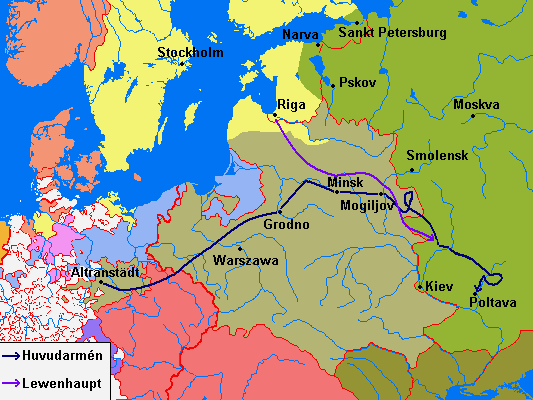
The map above shows
the movements of the Swedish armies during the Russian campaign
1707-1709. The Livgarde was part of the main army, but Lewenhaupt's
corps contained 3-männing soldiers and these were used to fill the
ranks of the Livgarde when they joined the main army. |
|
Jan.-May |
Winter quarters at Sandomierz |
|
May-Oct. |
The siege of Thorn |
|
Oct.-Dec.. |
Winter quarters in West Prussia |
1704 |
|
Jan.-May |
Winter quarters in West Prussia |
|
June-Sep. |
March West Prussia-Lemberg |
|
Sep.-Dec.. |
March Lemberg-Jutrosin |
1705 |
|
Jan.-July |
Winter quarters at Jutrosin |
|
July-Aug. |
March Jutrosin-Błonie |
|
Aug.-Dec.. |
Stay at Błonie |
1706 |
|
Jan.--March |
The blockade of Grodno |
|
April |
March Grodno-Pinsk |
|
May |
March Pinsk-Jarosławiec |
|
June |
Stay at Jarosławiec |
|
July-Aug. |
March Jarosławiec-Saxony |
|
Sep.-Dec.. |
Winter quarters in Saxony |
1707 |
|
|
Jan.-Aug. |
Stay in Saxony |
|
September |
March Saxony-Sokolnik |
|
October |
Stay at Sokolnik |
|
November |
March Sokolnik-Wlosawek |
|
December |
Stay at Wlosawek |
1708 |
|
In the battle of Holowczyn,
69 NCOs and privates were killed. The wounded were 485.
Officer casualties were 40 men. The high number of wounded in relation
to the killed is said to have been due to the Livgarde wading across
a river. This resulted in wet uniforms making it more difficult for
bullets to penetrate and thus fewer injuries that became fatal.
|
|
Jan.-Feb. |
March Wlosawek-Smorgon |
|
Feb.-May |
Stay in Lithuania |
|
June |
March to Holowczyn |
|
July |
Holowczyn & stay in Mogilev |
|
Aug.-Sep. |
Tatarsk, march to Severia |
|
Oct.-Dec.. |
March Kostenitji-Romny-Hadjatj |
1709 |
|
In the battle of Poltava
on
28 June, 24 officers were killed, which was almost a quarter of the
corps. In addition, 59 officers were captured (19 at Poltava, 30 at
Perevolochna and 10 at an unknown location). Of these, 25-33% were
wounded. Two Russian sources, which are not entirely reliable, state
that either 1,350 NCOs and privates, or alternatively 121 NCOs and
1,196 privates were captured at Perevolochna. Since the Livgarde
probably had a strength of about 2,500 men before the battle, this
would mean that half were killed or captured on the battlefield at
Poltava. |
|
Jan.-April |
March Hadjatj-Poltava |
|
April-June |
Siege of Poltava |
|
June |
Battle of Poltava |
1709-18 |
Garrison in Stockholm |
1718 |
|
|
Sep.-Oct. |
March Stockholm-Dalsland |
|
Nov-Dec. |
Campaign in Noway |
|
December |
Return march to Sweden |
Recruitment of the Livgarde
Together with the Artillery Regiment and the Adelsfana, the Livgarde was one
of the few truly national regiments which collected its recruits from all
over Sweden.
However, the Livgarde consisted almost exclusively of ethnic Swedes. The
guardsmen who came from Finland were for example concentrated to its Swedish
speaking regions. And despite of the strong national character the main
recruitment area can be localised to the central portions of Sweden (Svealand
and Östergötland) from where about 75 % of the recruits came.
The number of Stockholmers in the ranks was high but since most Swedes at
this time lived on the country side their share was not higher than 9 %.
A guardsman had a wage of 36 daler in silver the year 1696
(to be compared with the 33 daler which soldiers received in other enlisted
infantry regiments in proper Sweden). If he was promoted to underrotmästare
(= vice filemaster) he would get 41 daler. A rotmästare (filemaster)
received 50 and corporals got 63-66
daler. The lower NCO ranks (förare, furir &
rustmästare) received 90 daler in silver as their yearly wage while the
higher NCO ranks (fältväbel & sergeant) got 108. Lieutenants &
ensigns earned 378 daler, captains 556, the major 1,242, the lieutenant
colonel 1,306
and the colonel
2,056 daler. The income differences were enormous and even though the
private guardsmen earned more than their colleagues they could not support a
family on that wage. It was almost required that the soldier had a second
job and/or a wife who also worked. Because the burdens of military service
were light during peace time these second jobs could very well be the
soldiers' primary occupation.
When the Guard was overseas during the Great Northern War it was intended
that the recruitment was to be managed in such a way that each provincial
governor had a quota which they should recruit and send to the Livgarde. But
the first contingent of the governors recruits was far from the desired size
and not all of them met the requirement for service in the Livgarde.
Of the 510 men which the governors were to recruit only 250 of them were
actually added to the ranks in 1701 and not rejected at arrival. The
recruitment was thereafter centralised and this task was given to lieutenant
colonel Åke Rålamb. But the numbers did not increase and in 1702 only 285 recruits
arrived, followed by 190 men in 1703, 118 men in 1704 and 156 men in 1705.
The 1706 contingent (which arrived in
1707) consisted of 117 men and the 1707 contingent was 203 men strong. The 1708
contingent which arrived too late to Riga to join the main army consisted of 332 men
which were called back to Sweden in 1709. Rålamb managed to recruit 79 men to the
1709 contingent before he lost this assignment to the interim commander of
the restored Livgarde.
Since the recruits were not sufficient to fill the ranks of the growing
Livgarde, the King arranged for soldiers to be transferred from other
regiments. One company each from Tyska, Svenska and Drottningens
livregemente were ordered by the King in October 1701 to be transferred
to the Livgarde (these regiments garrisoned fortresses in Scania and the
Swedish west coast). In 1703
one battalion each from Uppland and Östgöta-Södermanland 3-männing regiments
were merged with the Livgarde (the former also included soldiers from the
provinces of Dalarna and Västmanland. An additional company each from
Svenska and Drottningens
livregemente were added the same year and in the next year 150 men from
Jämtland's Regiment was added to the Livgarde. Finally during the Russian campaign in
1708 the rest of these 3-männing regiments together with Småland and
Närke-Värmlands 3-männing regiments were merged with the Livgarde (altogether
approx. 1,000 men). Småland's 3-männing regiment had contributed 72
men to the Livgarde as early as September 1700, when a sharp increase in the
number of officers through promotions within the Livgarde had resulted in
vacancies.
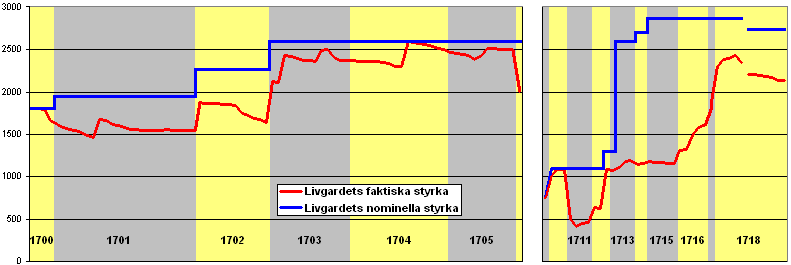
Strength of the Livgarde during the Great Northern War.
Nominal strength in blue and effective strength in red.
The period 1707-09 is missing because
the source material was lost in the capitulation at Perevolochna. The lines are
broken for the year 1718 because the company that was left in Stockholm is not included in the second
half of that year.
When the remnants of the Livgarde field regiment capitulated in at Perevolochna 1709
there were, counting the palace guard (120 men strong since 1702) and the
existing recruits, a force of about 600 guardsmen in Stockholm. These were
organised into new companies and the work to restore the Livgarde began.
However, the recruitment progressed at a slow pace and the organisation
consisted of just twelve companies for a long time. An important reason why
things went slowly in the beginning was a lack of initiative on the part of
the elderly governor of Stockholm, Knut Posse, who was most responsible for
the Livgarde's recruitment. It certainly did not
help either that the plague in 1710 killed 60 % of the then 1,000 men strong Guard.
Only 419 men remained at the muster in June 1711, and among them there
were several
palace guards who had been to old for field service already in 1700 (these
men included a 90-year old man who was discharged the following year).
Conscription of men from the mining region of Bergsslagen (previously exempt
from recruitment) helped to recover the Livgarde's strength but then for a
long period the strength stood still at 1,000 men.
Some of the difficulties with the recruitment can be explained by the fact
the lega (the amount of money the recruit was given directly when he
signed the contract) was only 20 daler of silver,
which made the Livgarde less attractive compared to other regiments. The men
who recruited for the Livgarde had to compete with all the rotebönder
(farmers tasked with recruiting one infantry soldier) and rusthållare
(men tasked with recruiting one cavalryman and horse) who at the same time
were searching for recruits to restore the provincial regiments. The
conditions in the soldiers market thus required (according the regimental
commander Ribbing) a lega of at least 33.33 daler in silver.
This request of raising the lega was however rejected by the royal
council on the ground of the poor financial state of the Crown. The
troubling economy also meant that salary payments were very irregular and
that the guardsmen often lived in misery. This, of course, made it even more
difficult to attract recruits to the Livgarde.
All this changed when Charles XII returned to Sweden in December 1715 and
could now personally deal with the restoration of his Livgarde. The
Livgarde's recruiters had already made themselves known for their hard-line
persuasion methods before then. But now a determined hunt began for men who
lacked employment, students who did not study diligently, and occupational
categories that were considered non-essential in time of war. The notion
that recruits were supposed to be volunteers was set aside and, without
sacrificing quality, the Livgarde's manpower increased so rapidly that it
was 2,200 strong when the Norwegian campaign began in 1718. But even this
work came to naught as a result of external circumstances. The king's death
led to an unplanned retreat to Sweden in the middle of winter. The Livgarde
also had the misfortune of marching last, so that those food storages that
did exist along the march route were empty when the Livgarde got there. The
result was a disaster and of the only 795 remaining guardsmen who were
mustered in Stockholm in 1719, half had to be discarded as unfit for
continued service.
By disbanding temporary regiments and transferring the men to the Livgarde,
its strength was able to recover so that in October 1720 it numbered 1,644
men. But even though the nominal strength of the Livgarde was reduced to
1,800 men in 1722, it would take until 1728 before that was achieved.
|
|
The Carolean Uniforms of the Livgarde
|
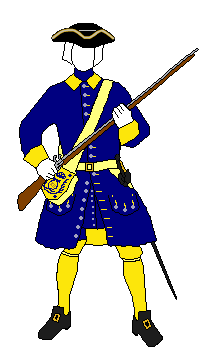
1697-1704 |
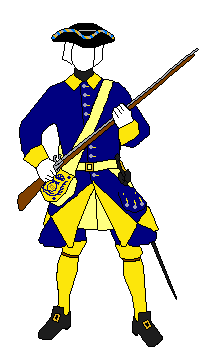
1704-1707 |

1707-1709 |
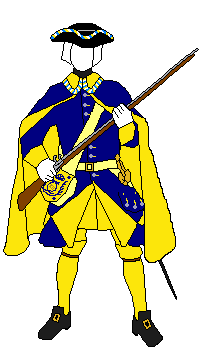
1710-1718 |
|
Colour of vest unknown. |
Vest unknown. Lace on the hat and the cloak's collar
is my interpretation of the sources' "gold, silver in silk". The other
changes
may have occurred when the
next uniform was issued in 1707 or perhaps even later. |
|
Hat lace is not mentioned and the cloak's collar is only
mentioned to have had "silk lace". I have guessed that the gold and
silver were replaced with yellow and white thread for economical
reasons. |
When
the Livgarde marched to war in April 1700 they wore uniforms that had been
issued in 1695. Although Charles XII had decreed a new uniform for his Guard
in 1699 it would not be until 1704 before the first
model 1699 uniforms were issued to the Livgarde. Then at last could the
3-männing soldiers, who had been added to the Guard in 1703, receive new
proper Livgarde uniforms instead of the red Saxon coats (captured in the
battle of Kliszow) which they had been forced to wear because of a shortage
of uniforms. As a part of the preparations for
the Russian campaign a second set of model 1699 uniforms were made in Saxony and
issued in April 1707.
But when the Livgarde was to be restored after the
battle of Poltava, the War College decided for a less expensive uniform. The
model 1709 uniform was then worn by the Livgarde for the remainder of the
war. Charles XII did however decree a new uniform model in 1716, similar to
the one from 1699. But due to delays it could not be delivered to the
Livgarde in time for the Norwegian campaign in 1718. During this campaign
the Livgarde was therefore among the worst dressed units. The lucky ones had
old worn uniforms from 1713, which was the last time the regiment had been
issued new uniforms. But since then the Livgarde's strength had more than
doubled, so roughly half of the guardsmen had not received any proper
uniforms at all. As an emergency solution, the Livgarde had been given 5,000
ell of vadmal (coarse wool) at the beginning of 1718 to remedy the
worst deficiencies. This should have been enough for coats, but the soldiers
complained in September 1718 especially about insufficient shoes and
stockings.
The descriptions below of the Livgarde's uniforms during the Great Northern
War are taken from Tor Schreber von Schreeb's article "Lifgardets
beklädnad och beväpning från Christina till Carl XII" and the pictures
are from Göte Göransson and Alf Åberg's book "Karoliner".
I have in purple text supplemented with information
from Folke Wernstedt's volume IV about the history of the Livgarde. The only uniform data that I have not included are those of oboists,
provosts and drivers.
A distinguishing feature of the uniforms of the Livgarde during the reign of
Charles XII is their "gold, silver in silk lace" which appeared on the hat
and cloak collar (but not the coat collar). What colour the silk was is
unclear, but Tor Schreber von Schreeb states that the silk was yellow and
blue, or only blue, and that it was decorated with gold and silver thread (note
4 page 66). However, Göte Göransson's pictures depict them as white edged
with gold and silver. And in the 1720s the silk seems to have been white (but
by then the gold thread had disappeared from the lace and other uniform
changes had taken place). I myself have made the lace striped in
gold-silver-blue in my pictures. But the actual pattern was probably more
decorative than that.
Note also that the
Livgarde grenadiers did not wear grenadier caps, they only had ordinary
tricornes
|
Livgarde Uniforms in
1695
(worn until January 1704)
Hat: black, decorated with hat band and
lace, for NCOs of silver. for oboists and the regimental pipers of "gold"
(i.e. gilded silver). Folke Wernstedt states the
privates had silver lace as well.
Cloak: of blue cloth, lining of yellow
baize; NCO's was decorated with "silver in gold lace" (lace of silver thread
with interwoven threads of gilded silver).
Coat: of blue cloth, lining of yellow baize
(mentioned only for corporals and privates). The NCOs' coats were adorned
with silver lace on the "sleeves and [pocket] flaps". The regimental piper's
of "gold in silver lace", the oboist's of the same lace and velvet on the
flaps, the drummers' and pipers' of "lace".
Vest: for NCOs of leather, for musicians of
blue cloth; lacing was of the same kind as on the coat.
Breeches: of blue cloth.
Stockings: some blue, some yellow.
Buttons: pewter for corporals and privates
of pewter, for others not specified. The number of
buttons on each pocket flap was in 1693: nine for officers, seven for NCOs,
five for corporals and three for privates.
Cartridge box: in the mid-1690s had lids
covered with yellow cloth, from 1699 with yellow and blue cloth. See Göte
Göransson's interpretation of this in the picture to the right. .
Neckcloth: was of white cloth which, until
1697, was tied at the front with a blue ribbon. Possibly the colour of the
neckcloth was changed to blue at the same time.
|
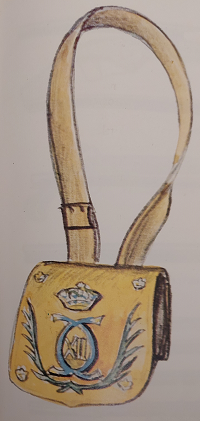
Cartridge box model 1716 interpreted by Göte
Göransson |
|
Officer's Uniform
Hat: Made of camel hair felt. Hat
band and wide lace of gold (gold lace = gilded silver).
Cloak: Blue cloth with gold lace on the
collar, front and back at the slit. Gilded buckles with crowned royal
name cipher.
Coat: Of finest blue cloth, cuffs of
blue velvet, pocket flaps decorated with the same; lining of blue
"rask" (= fabric with a thin shiny surface). "Framed" (edged) with
narrow gold lace and otherwise richly decorated with wide lace and
buttonhole lace in gold. "Gold thread buttons", after 1709 possibly
gilded brass buttons.
Vest (Camisole): Of cloth like the coat
and decorated in the same manners.
Breeches: Blue cloth.
Stockings: Made of blue yarn. Gilded
buckles on the knee straps.
Gloves Reindeer skin. the collars
decorated with the gold lace. The regimental officers probably also had
gold fringes.
Waist belt: Covered with gold lace,
lined with blue cloth. Buckle gilded.
Sword tassel: Made of gold. |
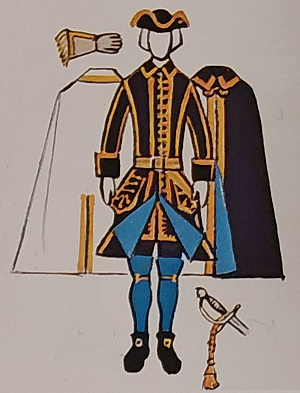 |
|
NCO Uniforms (m/1699 to m/1716)
(Göte Göransson has incorrectly
depicted officers and NCOs with lining and stockings in a lighter shade
of blue)
|
| |
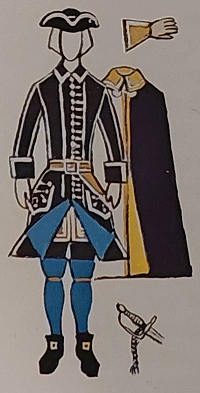
m/1699
(issued in January 1704 and April 1707) |
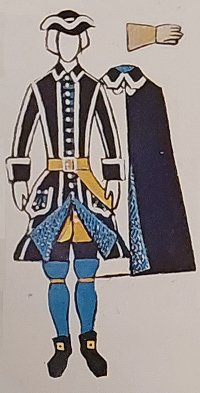
m/1709
(issued until October 1713) |
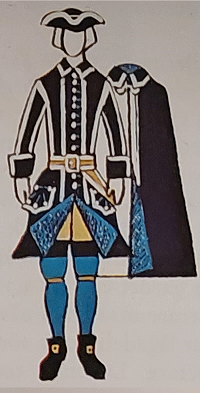
m/1716
(was not issued in time for the Norwegian campaign in 1718) |
|
Hat: |
Lace and hat band of silver. Silver plated button. |
Silver lace, one inch wide. Hat band of white thread. |
"With silver lace" |
|
Cloak: |
Blue cloth with fin yellow baize on the collar and
lesser baize for lining. Decorated with gold, silver in silk lace (8 ell)
on the front and and back on the slit as well as the collar. Silver
plated buckles with crowned royal name cipher. |
Blue cloth lined with blue "friserad" (= surface
made uneven) baize. One inch wide silver lace on the collar. "1 pair
of silver plated brass cloak buckles, 1 pair of small plain ones on the
back of the skirt". |
Blue cloth lined with fine blue "friserad" (= surface made
uneven) baize, decorated with
silver lace. "Silver plated brass buckles, large and small, with
Carolus". |
|
Coat: |
Blue of fine cloth, 5 ½ ell "of which is also taken for
collar and cuffs. Lined with blue "rask" (= fabric with a thin
shiny surface). Edged with 11 ¾
ell narrow lace and otherwise decorated on collar, cuffs and pocket
flaps" with 8 ¾ ell wide lace and 14
ell button hole lace, all of genuine silver. 40
large "round" (lumpy) buttons of fine English pewter. |
Blue cloth lined with blue "friserad" (= surface
made uneven) baize. Decorated with one inch wide silver lace (on the
cloak collar and coat, all together 8 ¼ ell). The button holes "edged
with blue cloth". 22 silver plated brass buttons. |
Blue cloth lined with fine blue "friserad" (= surface made
uneven) baize. Decorated with silver lace (on the cloak and coat, all
together 14 ell) Button hole lace of blue silk. 26 large "double silver
plated brass buttons and 6 smaller ones on the sleeves. |
|
Vest (Camisole): |
Made of buckskin (4 hides), lined with yellow "dwelck".
Edges (8 ell) and wide lace (5 ⅞ ell) of silver.
5 ½ dozen smaller pewter buttons. |
"Camisole of buckskin with yellow "lärft"
lining and English pewter buttons". |
Made of chamois-coloured cloth, lined with fabric (above the waist "väv""
and below with chamois-coloured "lärft"). 24 smaller buttons like
the coat. |
|
Breeches: |
Blue cloth. |
Blue cloth. |
Blue cloth. |
|
Stockings: |
Blue yarn ("redgarn") |
Blue-coloured "wool knit stockings" |
Blue yarn ("redgarn") |
|
Gloves: |
Rein deer skin "with decorated small collars". |
Elk skin collars and buckskin grips. |
Elk skin collars and buckskin grips. |
|
Waist belt: |
Decorated with wide silver lace and lined with blue "lärft". Silver
plated buckle. |
Plain made of elk skin with silver plated buckles. |
Made of ox leather, decorated with 4 ½ ell silver lace and silver plated
buckle. |
|
Sword tassel: |
Of blue silk with touches of silver. |
|
|
|
Corporals' and
Privates' Uniforms (m/1699 to m/1716)
(Göte Göransson's pictures below refer
to corporals, for privates see my pictures further up)
|
|
|
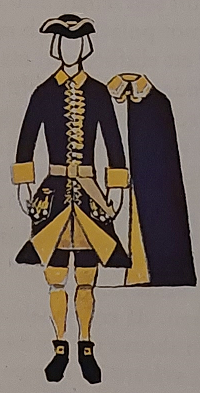
m/1699
(issued in January 1704 and April 1707) |
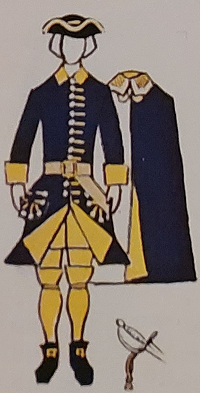
m/1709
(issued until October 1713) |
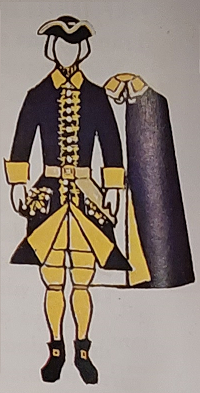
m/1716
(was not issued in time for the Norwegian campaign in 1718) |
|
Hat: |
Lace and hat band of gold and silver in silk. |
Decoration not mentioned.. |
Lace of silver and gold in silk. Hat band of "yellow and white
thread". |
|
Cloak: |
Blue cloth with "collar of fine [yellow] English
baize,
lined with lesser yellow baize; around the collar lace of gold and
silver in silk" (2 ell). Brass buckles with crowned royal name cipher. |
Blue cloth with a collar of "friserad" (=
surface made uneven) yellow baize and decorated with 2 ell "silk
lace". Lined with lesser yellow baize. |
Blue cloth with collar of yellow cloth, decorated with 2 ⅛ ell "lace of
silver and gold in silk". Lined with "friserad" (= surface
made uneven) yellow baize. |
|
Coat: |
Blue regular cloth "with yellow baize for
lining and fine [yellow]
baize for cuffs and collar".
Corporals: "Button holes with leaf work [likely acanthus
leaves] and double silk holes [yellow silk lace]". 31 large "flat"
pewter buttons and 6 smaller ones, the latter on the sleeves.
Privates: Single lace along the button holes (¾ lot yellow
silk instead of the corporals' 2 ½ lot). 26 large flat pewter buttons
and 6 smaller on the sleeves.
Corporals had five buttons on each pocket flap
while privates only had three. In 1707 the total amount of buttons for
privates were 19 or 20 large buttons (depending on the length of the
soldier) and 6 small buttons. |
Blue cloth with collar and cuffs of "friserad"
(= surface made uneven) yellow baize, lined with baize of lesser quality.
Along the button holes, yellow lace of camel hair yarn (2 lots). 19 "three-stamped
pewter buttons". |
Blue cloth with collar and cuffs of yellow cloth. Lined with "friserad"
(= surface made uneven) yellow baize.
24 large buttons "of three-stamped pewter and lathed with edge""
and 6 smaller ones on the sleeves. Corporals: "Double
button holes [lace] of twisted yellow camel hair yarn" with "leaf
work of yellow
silk [2 lots]".
Privates: had no lace or leaf work along the button holes. |
Cartridge box:
Lid made of yellow cloth
"with palm branches around the name [the royal cipher] sewn and a
small crown in all four corners". Se picture above.
Grenadier lids "with grenades and other
ornaments", they do not seem to have had palm branches and crowns like
the musketeers. |
|
Vest (Camisole): |
Not mentioned.
Yellow cloth in 1707. |
Yellow cloth. 18 smaller buttons like the coat. |
Yellow cloth lined with fabric ("väv"). 17 smaller buttons like
the coat. |
|
Breeches: |
Blue cloth in 1704
Yellow cloth in 1707. |
Yellow cloth. |
Yellow cloth. |
|
Stockings: |
"Yellow knitted stockings." |
Yellow. |
Yellow. |
|
Neck cloth: |
Made of black fabric. |
|
One made of black and yellow crepon", one made of whitet "lärft". |
|
Gloves: |
Elk skin collars and buckskin grips. |
Collars made of ox leather. |
Collars made of ox leather. |
|
Waist belt: |
Made of ox leather with brass buckle. |
Made of ox leather with brass buckle. |
Made of ox leather with brass buckle. |
|
Sword tassel: |
|
Leather ("smorläder"). |
Leather ("smorläder"). |
|
Drummers' and Pipers'
Uniforms (m/1699 till m/1716)
(The blue colour on the stockings on Göte
Göransson's m/1716 must be a mistake, it should be yellow)
|
|
|
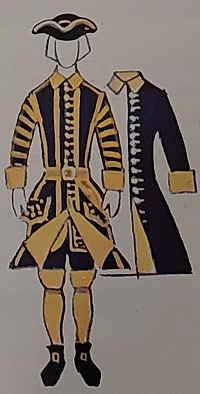
m/1699
(issued in January 1704 and April 1707) |
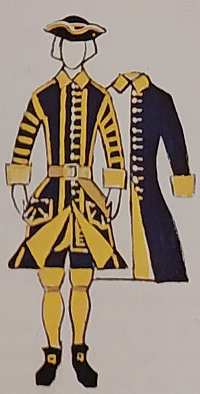
m/1709
(issued until October 1713) |
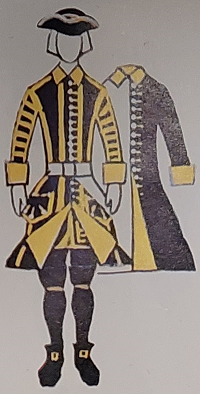
m/1716
(was not issued in time for the Norwegian campaign in 1718) |
|
Hat: |
Lace and hat band of gold and silver in silk. |
"With sweatband and set together with a hat band twice around the
hill with white and yellow thread, and silk lace along the edge." |
Lace of "silver and gold in silk. Hat band of yellow and white thread". |
|
Piecoat: |
Piecoat of blue cloth. "The cuffs and collar of fine yellow baize and
lined with yellow lining baize. Decorated with "1 ½ dozen camel hair "litser"
(lace made of blue and yellow camel hair yarn). 18 pewter buttons. |
Piecoat of blue cloth and lined with yellow baize. 18 pewter buttons
like the coat. |
Piecoat of blue cloth and lined with "friserad" (= surface made
uneven) yellow baize. 18 pewter buttons like the coat. |
|
Coat: |
"Coats of fine blue cloth, lined on the cuffs and the "flaxor" [fabric
hanging on the shoulders] with yellow "rask" [= fabric with a
thin shiny surface] and underneath with lesser yellow baize, with [48]
gold, silver in silk buttons, decorated with gold and silver i silk
lace" (on the coat and vest, 54 ell in total). |
Coat of blue cloth with collar and cuffs covered with "friserad"
(= surface made uneven) yellow baize, lined with baize of lesser quality.
On the coat and vest, 53 ell
"lace of gold, silver in silk" in total and "2 lots yellow twisted
camel hair yarn for the button holes". 18 "three-stamped pewter buttons
with stripe". |
Coat of blue cloth with collar and cuffs of yellow cloth, lined with "friserad"
(= surface made uneven) yellow baize.. On the coat and vest, 30 ell "silver
and gold in silk lace" in total, 17 ½ ell edging lace of the
same kind and 2 lots camel hair yarn for button hole lace. 27 large and 6
smaller buttons "of three-stamped pewter and lathed with edge"" |
|
Vest (Camisole): |
Blue cloth, decorated like the coat. 36 smaller buttons like the coat. |
Blue cloth, lined under the waist with yellow baize; regular lace and
button hole lace (see the coat). 18 smaller buttons like the coat. |
Blue cloth lined under the waist with "friserad" (= surface made
uneven) yellow baize. Decorated like the coat. 23 smaller buttons like
the coat. |
|
Breeches: |
Blue cloth. |
Blue cloth. |
Blue cloth. |
|
Stockings: |
Yellow. |
Yellow. |
Yellow. |
|
Gloves: |
|
Collars of ox leather and buckskin grips. |
Collars of ox leather and buckskin grips. |
|
Waist belt: |
Decorated with 7 ½ ell gold and silver in silk lace.
Drum strap decorated with wider lace of the same (5 ¼ ell). |
Made of ox leather with brass buckle. Drum
strap of ox leather. |
Made of ox leather with brass buckle. |
|
Hair pouch: |
|
Made of black "dwelck" with lace. |
|
|
Liberty Age Uniforms |
|
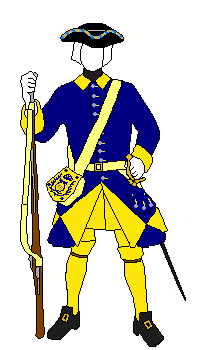
m/1716
(issued at the turn of the year 1718-19) |
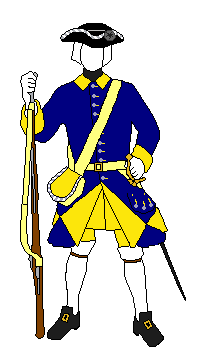
m/1724-1728
(issued in 1729) |
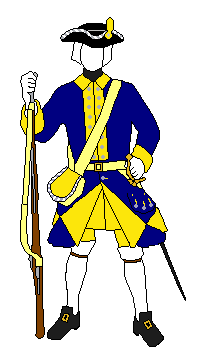
"m/1750s"
(was in use no later than 1759) |
Charles XII's m/1716 uniforms (as described in the tables above) were
finally completed and sent from Stockholm to the main army in two batches in
early November and early December 1718. However, by then the king was dead
and the campaign was over. They thus became the Livgarde's first uniform
during the new era that began in 1719. From 1724, however, several changes
took place in the Livgarde's uniform regulation. The most noticeable thing
was that the stockings now became white and that the hat brim was changed so
that the gold thread disappeared and the silk in it became white (although,
the silk may have been white all along and not blue as in my pictures above).
In addition, a black cockade was added to the hat. The cartridge box was to
be decorated with silver and white silk lace on the lid, which continued to
be of yellow cloth. I have no information about any additional decorations
but probably the lid was also adorned with the royal monogram as in Charles
XII's time. The new uniform was issued in 1729.
The non-commissioned officer uniform also changed greatly with the m/1724.
The former all-blue uniform now received pale yellow (chamois) facings,
waistcoats and trousers and, like the privates, white stockings. When the
uniform regulation was changed again in 1728, another innovation was made to
the non-commissioned officers' uniform (and the drummer's uniform). They
were to have lapels on the coat, which at this time was a common feature on
European uniforms. In Sweden, on the other hand, it was unusual and became a
distinctive feature of the Livgarde's officers and NCOs. It was only during
the 1750s that the privates also received lapels.
|
|
m/1724,
m/1726 and
m/1728
(information taken from Lars
Ericsson's article in Meddelanden från Armémuseum 45-46) |
|
NCOs |
Privates |
Drummers |
|
Hat: |
Two finger wide silver lace, one silver-plated brass
button for attachment and a cockade of double black taffeta with
sewn-on brass thread.
Silver lace and cockade as well as a black horse hair button. |
Regular black hat with white lace with silver and round
pewter button. Cockade of black taffeta and sweatband.
Silver in silk lace |
|
|
Cloak, piecoat: |
|
Cloak with silver in silk lace on the
collar and large white metal buckles and a pair of smaller brass buckles. |
Piecoat of blue cloth lined with yellow "friserad"
(= surface made uneven) baize. |
|
Coat: |
Blue with chamois collar and cuffs.
Blue lined with chamois "friserad" (= surface made uneven) baize, .chamois
cuffs and lapels and) and white buttons. |
Blue regular cloth lined with yellow "friserad" (=
surface made uneven) baize both in the sleeves and under the waist. |
Blue regular cloth with yellow collar and cuffs.
Lace with silver edged silk (it is not clear if it is for the hat or the
coat). |
|
Vest (Camisole): |
Chamois cloth underlined with "friserad" (=
surface made uneven) baize.
Chamois cloth lined with "friserad" (= surface made uneven) baize
and fabric ("väv"). |
Yellow cloth lined with fabric ("väv"). |
Yellow regular cloth lined with fabric ("väv"). |
|
Breeches: |
Chamois cloth lined with fabric ("väv").
Chamois cloth lined with fabric ("väv"). and pewter button. |
Yellow cloth lined with fabric ("väv"). |
Blue lined with fabric ("väv"). |
|
Stockings: |
White knitted yarn ("redgarn") stockings.
White yarn ("redgarn") stockings. |
White wool stockings. |
|
|
Gloves: |
Large pointed elk skin collars with reindeer skin grips. |
Regular gloves.
Two pair of grips made buck leather and reindeer leather respectively. |
|
Exactly when
lapels were introduced on the privates' uniforms is unclear. But the War
College noted in 1759 "that some time ago, the Royal Livgarde on the
coats used so-called lapels on the chest", which contradicted the
Parliament's ban on "all kinds of excesses and haughtiness occurring in
the army" and the King had also forbidden the Livgarde officers from
using lapels the year before. Despite this, the War College suggested that
all personnel should have lapels so that the Livgarde would distinguish
itself from the other regiments.
|
Hats also changed during the
1750s. The corporals received in 1751 silver lace on their hats just like
the non-commissioned officers. Also, both corporals and privates would have
"tassels" on their hats, which were introduced on NCOs' hats only in 1773. I
have no further description of what the tassels looked like. However, there
are two contemporary depictions of the m/1765 uniform that have different
types of tassels and they may be clues to what its predecessors looked like.
A more discreet type of tassel (in silver and/or white silk?) appears in
Jacob Gillberg's model drawings below, while an unknown artist in the
picture to the right has depicted the Livgarde with a long yellow pompom.
It was also noted in 1759 that the Livgarde's hats differed from the "indelta"
regiments by having "a pointed and shallow hill".
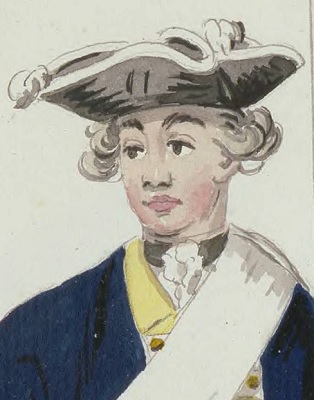
Close-up of the hat, from Jacob Gillberg's drawing of the Livgarde's
m/1765-uniform. |
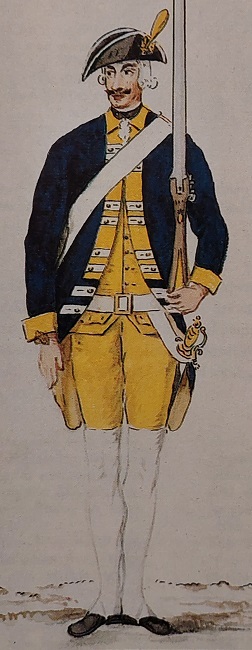
Livgarde m/1765 uniform by unknown artist. |
After the
Pomeranian War, a completely new uniform regulation for the Swedish army was
introduced in 1765. The cut of the coat changed and black gaiters to cover
the stockings became standard. For the Livgarde, the button colour was also
changed from pewter to brass. However, the black gaiters were not popular
with the regimental commander who in 1772 complained that the Livgarde was
expected to wear white gaiters. He got his way, which means that the image
above on the right may give a better picture of what the Livgarde's m/1765
uniform actually looked like than Jacob Gillberg's model drawings below. In
any case, it was replaced in 1780-1781 by the Gustavian uniform (m/1779).

NCO, private and drummer with uniform m/1765 (drawn
by Jacob
Gillberg).
|
|
Livgarde Colours during
the 18th Century

Reconstruction of m/1686 colonel's colour
(no model drawing is preserved and the motto is likely incorrect) |

Olof Hoffman's model drawing of m/1686 company colour |
According to
the regulation from 1686, the Livgarde's company colours were to look like
the picture above to the right (Olof Hoffman's model drawing). The motif consists of the
king's crowned mirrored monogram carried by two crowned lions in a white
field strewn with crowns. At the top was a motto written in Latin. The
colonel's colour was the same except that the royal monogram in the middle
was replaced by Sweden's greater coat of arms. The intent was probably that
each individual colour would have its own motto at the top, but in the set
produced in 1710, all company colours had the same motto as in the model drawing.
However, the fragmented colonel's colour appear to have had a separate motto.
All of the preserved colours from the 17th century did have individual mottos. The 1686
regulation probably did not result in any changes in the appearance of the
Livgarde colours.
The first
m/1686 set of twelve colours was issued in 1690 and the old colours were
then donated to the regimental commander Bernhard von Liewen. But in
September 1700 the Livgarde was reorganised from twelve to eighteen
companies and the new companies needed their own colours. Charles XII
therefore asked von Liewen to return the six older colours that were in the
best condition. These older colours were likely not delivered to the
Livgarde in time for the Battle of Narva on 20 November, but should have
been used during the Battle of Düna on 9 July 1701. It is written in Captain
Olof Stiernhöök's diary that his company received a colour on 26 December
1700.
|
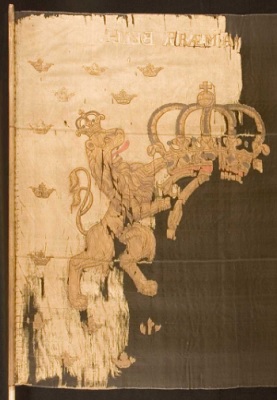 |
Company
colour from either 1680 or 1690
HINC PRÆMIA BELLI
(Hence the rewards of war)
295. Colour. Flag:
originally a height of 216 cm, present width 143 cm.; of white taffeta,
upon painted in gold, the same on both sides, Charles XI's cypher, large
double C underneath large closed crown with red lining; the cypher is
supported by two crowned lions with red tongues; on the bottom small
scattered open crowns; along the upper edge on the inner side HINC PRÆMIA
[BELLI •], on the outer [HINC] PRÆMIA
BELLI •; Attached with strongly domed, gilded nails and satin ribbon in
white and yellow, which continues tightly wound about the staff 38 cm. below,
attached with nails going in a spiral. Staff: length 265 cm.;
diameter
on the top 3
cm., below the flag 3,5 cm.; of pine, painted white.
Of the flag about half remains, relined on tulle;
painting well preserved; the flag taken from the staff, which is cut off
below;
finial is missing. Colour at the Livgarde, probably older than 1686. |
However, after a year of campaigning, the colours from the 17th century were
deemed to be worn out. In April 1701, a new set of 18 colours was therefore
ordered, painted by Olof Hoffman on canvases of "grein de Neapole croisse".
In this set, which was completed in October 1701, three colours were
decorated with grenades in the corners. These were intended for the three
grenadier companies that had been formed in September 1700, but they did not
come into use until November 1702 when the Livgarde was expanded with three
regular companies. Apparently the king had decided that grenadier companies
should not have colours. This was already the case when the colours were
completed since Charles XII wrote to the War College on 29 October 1701 and
mentioned that "in grenadier companies no colours are used", and this did
not change when three more grenadier companies were created in August 1703.
Olof Hoffman's set was lost to the Russians at Poltava and Perevolochna in
1709. Their descriptions mention that the finials were engraved and made of
gilded copper. All colours were taken to Moscow and destroyed in 1737 when
the Kremlin burned down.
In the Battle of Poltava, however, the Guard battalions did not only carry
the Livgarde colours. During the Russian campaign, men from disbanded
3-männing regiments had been used to fill vacancies in the Livgarde
companies. Their old 3-männing colours were carried alongside the 18
Livgarde colours. The exact number of 3-männing colours during this battle
is not known, but they were generally red with various central Swedish
provincial coat of arms in the upper inner corner. The only exception was
the Småland 3-männing regiment that had yellow colours (and at least two of
these had Jönköping's coat of arms in the upper inner corner).
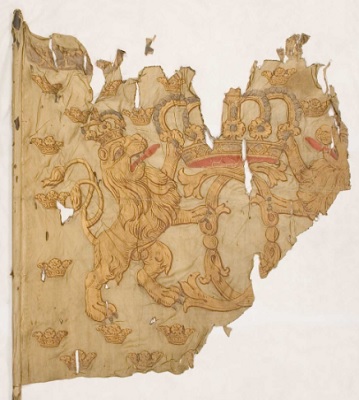
Company colour from 1710
After the disaster in Ukraine, the Livgarde was to be restored to its former
strength. But recruitment was slow and the organisation stayed for a long
time at twelve companies and it was also this number of colours that were
produced in 1709-1710 (see picture above and below). All colours had the
same motto as in the model drawing, but one deviation was that the gold text
had a silver background. The staffs were painted with dark brown paint.
However, the quality of these flags may not have been the best as the
regimental commander ordered 19 colours made of Persian damask flags in 1716
(the nineteenth colour should have been intended for the company guarding
the palace). But it doesn't seem like any new colours were delivered. In
1719 the new regimental commander complained that the colours from 1710 were
worn out, and while waiting for new colours to be delivered, he requested as
a provisional solution the colours that had been used at Ulrika Eleonora's
coronation. That did happen, but only after Fredrik I's coronation the
following year.
These twelve "coronation colours" had been ordered from France as early as
1679 and were intended for the Livgarde, but the delivery took so long that
other colours were made instead. By 1703 at the latest, however, they must
have been stored in Stockholm. Fragments of one of these banners are
preserved in the Army Museum. They were never returned when a new set of
colours was issued and were probably used as so-called "sentry colours".
This type of colour was used in daily service to avoid wear and tear on the
ordinary colours and they were usually made of cheaper materials.
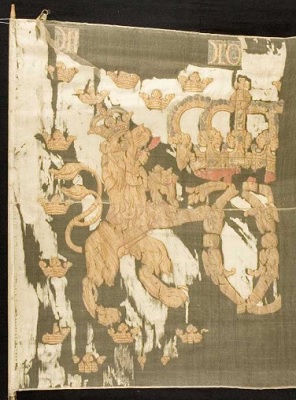 |
Company
colour from 1710
DILECTUMQUE
DEO NULLA RUINA PREMIT
(The one chosen by God fear no defeat)
296 (86). Colour.
Flag: originally a height oh 178 cm., present width 136 cm.; of white
taffeta, upon painted in gold, the same on both sides. Charles XI's cypher,
large double C underneath large closed royal crown with pearls in silver and
red lining; the cypher is supported by two crowned double tailed lions with
red tongues; along the upper edge on silver base, on the inner side DIL[ECTUMQUE] DEO [NULLA RUINA PREMIT],
on the outer [DILECTUMQUE DEO NU]LLA [RUINA PRE]MIT; on the bottom
small scattered open crowns; attached with gold ribbon and gilded nails. Staff: length 350
cm.; diameter on the top 3,4 cm., below the flag 3,6 cm.; of pine, painted
dark brown;
right underneath the flag covered 18 cm. below with white taffeta, attached
with four rows of nails and gold ribbons.
The flag very broken, in older time patched; consists
only of loose pieces relined on tulle; of the inscription only two fragments
remain;
taken from the staff and again nailed to the same, but obliquely and with
longer flag than before, marks from the old nails still visible (and from
them have the measurements been taken); finial missing. Colour at the
Livgarde according to Charles XI's regulation of 17 March 1686. A deviation
from the model drawing kept in the War Archive is that the inscriptions has
been painted on a silver base and not directly on the flag. Those fragments
listed under the following number probably belonged to a colour of the same
set as this one. |
It would take
until 1726 before the Livgarde received a new set (12 regular colours and
two sentry colours). However, the appearance of these did not follow m/1686,
but had been greatly simplified. Only the king's crowned monogram remained.
The lions and the scattered crowns were gone. Instead three were closed
crowns in the corners and a company symbol in the fourth corner. The company
symbol should have been in one of the upper corners. The appearance of the
company symbols is unknown but possibly the signs of the Zodiac may have
been used as symbols. With this set, the manufacturing technique had also
changed so that the colours were henceforth embroidered and not painted. No
colours in this set are preserved. The sentry colours were quickly worn out
and three new ones were delivered in 1732-33 and three more in 1737.
The 1726 set
was replaced in 1748 with fifteen new colours (no sentry colours were
issued so probably the old regular colours were used instead). This set had
no company symbols and instead there were crowns in all the corners. In
addition, the crowns were now open and not closed. In their original state,
they had Fredrik I's mirrored monogram as a motif, but after Adolf Fredrik
became king in 1751, the colours were modified so that an A was embroidered
over the mirrored F's.
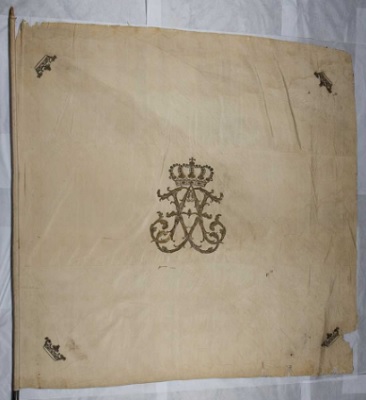
Company colour from 1748, modified in 1751 |
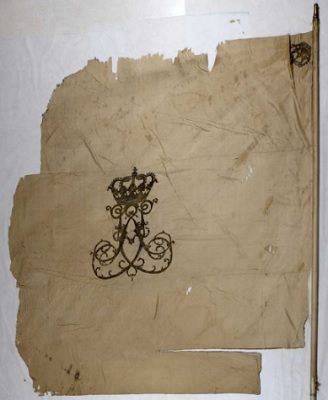
Company colour from 1762 or 1763 |
In 1762, six new colours were embroidered (one of which was a colonel's
colour) and in addition two sentry colours. These were supplemented in 1763
with nine more company colours. The difference to the previous set was that
the crowns in the corners were now closed again. These were then in use
until 1771-72 when a new set of fourteen colours was delivered. The only
difference to the previous set was that Adolf Fredrik's monogram was
replaced with Gustav III's. New sentry colours had to wait until 1778-79
when two such were paid for by the regimental commander himself and in 1784
when the crown paid for two sentry colours. A new set of only eight Livgarde
colours was embroidered in 1786 and it is said to have had the same
appearance as the previous set.. The last Livgarde colours of the 18th
century were issued in 1798 (1 colonel's colour, 9 company colours and 2
sentry colours) and were in use throughout the reign of Gustav IV Adolf,
with the exception of the sentry colours which were discarded after two
years).
Links to Preserved Colours
Colour sheets
|
The following images are free-to-use colour sheets for those who want to
paint miniature figure to represent the Livgarde. The company colour below is identical
with Olof Hoffman's model drawing while the two to the right are my
reconstructions of the colonel's colour and the colours intended for
the grenadier.
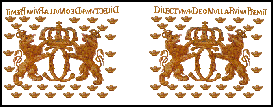 |
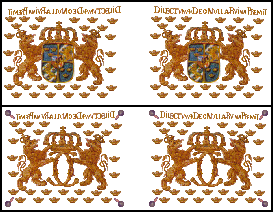 |
|
|
Other Equipment
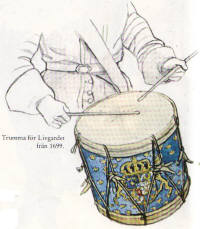 The
Guard's drums were in
1699 blue but otherwise had the same appearance as the colours. Just like
with the colours the colonel's company was different by having the Swedish
coat of arms on their drums instead of the royal cipher. The image which is
drawn by Göte Göransson and taken from his and Alf Åberg's book "Karoliner"
shows how the colonel's company's drums looked like. The
Guard's drums were in
1699 blue but otherwise had the same appearance as the colours. Just like
with the colours the colonel's company was different by having the Swedish
coat of arms on their drums instead of the royal cipher. The image which is
drawn by Göte Göransson and taken from his and Alf Åberg's book "Karoliner"
shows how the colonel's company's drums looked like.
At the same time the Guard officers were supposed to be armed with 5 ell (=
almost 3 metre) long half-pikes with brown shafts.
The NCOs were armed with halberds with unpainted shafts.
Unfortunately I have no information about the colour of the privates' pikes.
But considering the officer and NCO pole arms as well as the fact
that the staffs for the set of colours issued in 1710 were painted dark brown, the pikes were most
likely brown, either because they were painted or because they were of
unpainted wood.
During peacetime, the musketeers of the Livgarde had been armed with
matchlock and snaplock muskets. These were exchanged for new flintlock
muskets at the outbreak of war. However, the grenadiers had previously had
flintlock muskets with bayonets. The grenadiers' weapons then proved so
effective at the landing at Humlebæk that Charles XII ordered that the
musketeers should also have this type of flintlock musket fitted with a
bayonet. At the end of October, the Livgarde therefore replaced their
muskets in Reval and were thus able to fight with bayonets in the Battle of
Narva a month later.
|
|
References
Bellander, Erik. Dräkt och uniform. Stockholm (1973).
Cederström, Rudolf. Svenska kungliga hufvudbanér. Stockholm (1900).
Ericson, Lars. Fastställda uniformsmodeller för svenska armén under 1720-talet
(article in MAM 45-46). Stockholm (1986).
Schreber von Schreeb, Tore. Lifgardets beklädnad och beväpning från Christina till Carl XII
(article in MAM 7). (1945).
Törnquist, Leif. Fanorna vid de svenska liv- och hustrupperna (article in SVSS-NS XXI). Stockholm (2006).
Wennerholm, J Bertil R. Emporterade troféer. Bohus (2000).
Wernstedt, Folke – Cson Barkman, Bertil et al. Kungl. Svea livgardes historia. Stockholm (1937-1976).
Åberg, Alf – Göransson, Göte. Karoliner. Stockholm (1976). |
|

